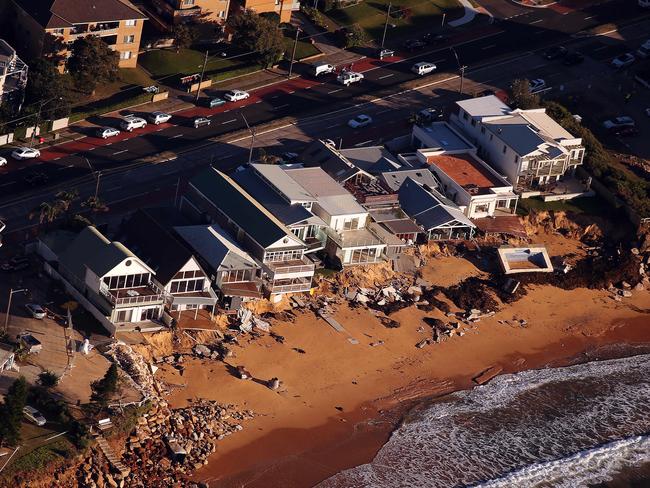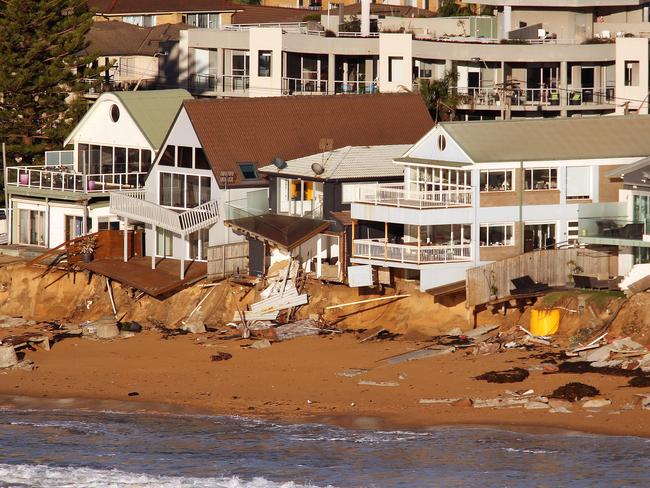Two weeks on a solution to Collaroy’s erosion problems remains unclear
After the destruction on the Collaroy coastline, there is no agreement on what to do to ward off future damage, writes Robbie Patterson

Nth Beaches
Don't miss out on the headlines from Nth Beaches. Followed categories will be added to My News.
Savage storms that ripped through Collaroy and left a strip of houses hanging on a knife’s edge may have exposed an even bigger problem for the northern beaches.
About 15m back from the deepest erosion point lies Pittwater Rd.
Residents Zaza and Garry Silk said they lost up to 30m in one day. With another high tide brewing this weekend, the northern end of a major road lies on their front doorstep.
And it could be the next victim of coastal erosion unless quick action is taken. There have been rumblings from the residents that they should not be paying for a sea wall that will protect a state-owned road.
Mr Silk is the spokesman for the residents who own the houses that were evacuated on June 5. He has said a large number of them are not filthy rich, as was widely perceived.



In some situations, he said, people were struggling to scrape up the money for interim works for this weekend, let alone the expected $140,000 they will likely fork out for a permanent sea wall.
Among those living on the strip are small business owners, tradies and retirees.
“I said to the premier – we lost 25 to 30m on Sunday, you could just see it was going,” said Mr Silk on the Tuesday after his home was hit by the king tide.
“It took the council workers back a bit. They were all in my back garden, the engineers, and all of a sudden it just went.
“I think they were shocked because up until then they had been pretty reassuring and then all of a sudden they realised it was a bit worse than they thought.”
That was almost a fortnight ago and still no long-term solution has been put forward.
Northern Beaches Council administrator Dick Persson is leading the charge for a sea wall, much to the dismay of greener-thinking residents. However, he has said on more than one occasion in the past fortnight that a sea wall was not a permanent solution, merely a “midterm” one.
“Around the world, we are seeing more frequent big storms happening and I think, around the world, we have to start to recognise that we have to have a longer-term plan in the framework,” he said.
“I am hoping at some stage that the Federal Government might show some interest, because I think offshore sand dredging is the only way that can nourish these beaches to the extent that may give us some long-term future recreation on them.”

Wakehurst state Liberal MP Brad Hazzard has made many visits to the site. He also believes the best way forward is to involve the Federal Government.
He said residents would “like a more comprehensive solution that goes beyond the 10 properties”.

“My view, as a coastal MP, is that this great continent has these sorts of issues form time to time around the entire continent and I think the Federal Government should take a responsibility to contribute,” he said.
But he stressed it must be a collaborative approach between all levels of government, rather than “one or the other”.
State Planning Minister and Pittwater Liberal MP Rob Stokes signed off on a coastal zone management plan for the then-Warringah Council in 2014.
Coincidentally, a bill was passed just five days before the storm hit to secure $83.6 million in funding for coastal management across the state, some of which may go towards a sea wall at Collaroy.
In his speech upon passing the bill, Mr Stokes echoed sentiments of academics in the Journal of Environmental Science and called for federal funding to protect our coastlines.
“While it is important that states provide for integrated coastal zone management, as we do in this bill, we recognise that the challenges faced by coastal communities are real,” he said in the speech.
“We know how important our beaches are to every Australian. It is incumbent on all of us to use our best efforts to ensure that our laws are modern and consistent and protect the interests of current and future generations.”

One long-term solution could be the one thing everyone has ruled out – a land buyback. But one expert, Professor Andrew Short from the School of Geosciences at the University of Sydney, believes if the beach was nourished properly, a buyback may not be necessary.
He said there were three expensive options to save Pittwater Rd: building a sea wall, buying the land back from residents or nourishing the beaches. Then there was the cheap one – to do nothing – which was probably why it was the option taken so far.
“They really do need federal assistance, not just at Collaroy, but statewide and nationwide – there is no simple solution,” he said. “If you buy them back at market value, that way nobody loses out … then you have a parkland and would give you decades until you have to worry about Pittwater Rd.”
But if offshore dredging – removing sand from the deep ocean and putting it back in the basin – was undertaken to provide “massive nourishment”, it could be a solution that lasts for centuries.

“If you wanted to, you could nourish Narrabeen beach,” Prof Short said. “It would give you centuries of life, unlike the Gold Coast, where you have to nourish every year, the sand will stay there. While it is an expensive option, it is more long term.”
The expected cost would be tens of millions of dollars.
But if you compare it with the likely costs of the clean-up, which are still unknown, and the previous century’s worth of storms that have threatened homes, it may be the cheaper option in the long run.
The council does undertake beach nourishment, with tens of thousands of cubic metres of sand being pushed back into the Narrabeen-Collaroy basin. But if it were to be increased to one million cubic metres, it would solve the issue, Prof Short said.
“It is definitely beyond the scope of councils to look at and perhaps beyond the states,” he said. “There should be a federal contribution. Nourishment is the best option you have. You don’t need a sea wall if you have massive nourishment.”


